Henri de Toulouse-Lautrec
Henri Marie Raymond de Toulouse-Lautrec-Monfa (24 November 1864 – 9 September 1901), commonly known as just Henri de Toulouse-Lautrec (UK: /ˈɒnri də tuːˌluːz loʊˈtrɛk/ ON-ree də too-LOOZ loh-TREK, US: /ɒnˈriː -/ on-REE -, French: [ɑ̃ʁi də tuluz lotʁɛk]), was a French painter, printmaker, draughtsman, caricaturist, and illustrator whose immersion in the colorful and theatrical life of Paris in the late 19th century allowed him to produce a collection of enticing, elegant, and provocative images of the modern, sometimes decadent, affairs of those times.
Henri de Toulouse-Lautrec | |
|---|---|
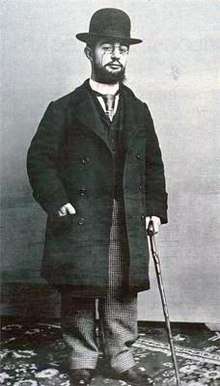 | |
| Born | Henri Marie Raymond de Toulouse-Lautrec-Monfa 24 November 1864 |
| Died | 9 September 1901 (aged 36) Saint-André-du-Bois, France |
| Resting place | Cimetière de Verdelais |
| Nationality | French |
| Education | René Princeteau, Fernand Cormon |
| Known for | Painting, printmaking, drawing, draughting, illustration |
Notable work | At the Moulin Rouge |
| Movement | Post-Impressionism, Art Nouveau |
Toulouse-Lautrec is among the best-known painters of the Post-Impressionist period, with Paul Cézanne, Vincent van Gogh, and Paul Gauguin.
In a 2005 auction at Christie's auction house, La Blanchisseuse, his early painting of a young laundress, sold for US$22.4 million and set a new record for the artist for a price at auction.[1]
Early life
Henri Marie Raymond de Toulouse-Lautrec-Monfa was born at the Hôtel du Bosc in Albi, Tarn, in the Midi-Pyrénées region of France, the firstborn child of Alphonse Charles Comte de Toulouse-Lautrec-Monfa (1838–1913)[2] and his wife Adèle Zoë Tapié de Celeyran (1841–1930).[3] The last part of his name means he was a member of an aristocratic family (descendants of the Counts of Toulouse and Odet de Foix, Vicomte de Lautrec and the Viscounts of Montfa, a village and commune of the Tarn department of southern France, close to the cities of Castres and Toulouse). His younger brother was born in 1867 but died the following year. Both sons enjoyed the titres de courtoisie of Comte.[4] If Henri had outlived his father, he would have been accorded the family title of Comte de Toulouse-Lautrec.[5]
After the death of his brother, Toulouse-Lautrec's parents separated and a nanny eventually took care of him.[6] At the age of eight, Toulouse-Lautrec went to live with his mother in Paris, where he drew sketches and caricatures in his exercise workbooks. The family quickly realized that his talents lay in drawing and painting. A friend of his father, René Princeteau, sometimes visited to give informal lessons. Some of Toulouse-Lautrec's early paintings are of horses, a specialty of Princeteau, and a subject Lautrec revisited in his "Circus Paintings".[6][7]
In 1875, Toulouse-Lautrec returned to Albi because his mother had concerns about his health. He took thermal baths at Amélie-les-Bains, and his mother consulted doctors in the hope of finding a way to improve her son's growth and development.[6]
Disability and health problems
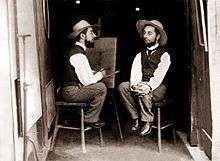
Toulouse-Lautrec's parents, the Comte and Comtesse, were first cousins (his grandmothers were sisters),[6] and his congenital health conditions were attributed to a family history of inbreeding.[8]
At the age of 13, Toulouse-Lautrec fractured his right femur, and at 14, he fractured his left femur.[9] The breaks did not heal properly. Modern physicians attribute this to an unknown genetic disorder, possibly pycnodysostosis (sometimes known as Toulouse-Lautrec Syndrome),[10] or a variant disorder along the lines of osteopetrosis, achondroplasia, or osteogenesis imperfecta.[11] Rickets aggravated by praecox virilism has also been suggested. Afterward, his legs ceased to grow, so that as an adult he was extremely short (1.42 m or 4 ft 8 in).[12] He developed an adult-sized torso while retaining his child-sized legs.[13] Additionally, he is reported to have had hypertrophied genitals.[14]
Physically unable to participate in many activities enjoyed by boys his age, Toulouse-Lautrec immersed himself in art. He became a prominent Post-Impressionist painter, art nouveau illustrator, and lithographer, and, through his works, recorded many details of the late-19th-century bohemian lifestyle in Paris. Toulouse-Lautrec contributed several illustrations to the magazine Le Rire during the mid-1890s.[15]
After initially failing college entrance exams, he passed his second attempt and completed his studies.
Paris

During a stay in Nice, France, his progress in painting and drawing impressed Princeteau, who persuaded Toulouse-Lautrec's parents to let him return to Paris and study under the portrait painter Léon Bonnat. He moved to Paris in 1882.[17] Toulouse-Lautrec's mother had high ambitions and, with the aim of her son becoming a fashionable and respected painter, used their family's influence to get him into Bonnat's studio.[6] He was drawn to Montmartre, the area of Paris famous for its bohemian lifestyle and the haunt of artists, writers, and philosophers. Studying with Bonnat placed Toulouse-Lautrec in the heart of Montmartre, an area he rarely left over the next 20 years.
After Bonnat took a new job, Toulouse-Lautrec moved to the studio of Fernand Cormon in 1882 and studied for a further five years and established the group of friends he kept for the rest of his life. At this time, he met Émile Bernard and Vincent van Gogh. Cormon, whose instruction was more relaxed than Bonnat's, allowed his pupils to roam Paris, looking for subjects to paint. During this period, Toulouse-Lautrec had his first encounter with a prostitute (reputedly sponsored by his friends), which led him to paint his first painting of a prostitute in Montmartre, a woman rumored to be Marie-Charlet.[6]

Early career
In 1885, Lautrec started to exhibit his work at the cabaret of Aristide Bruant's Mirliton.[18]
With his studies finished, in 1887, he participated in an exposition in Toulouse using the pseudonym "Tréclau," the verlan of the family name "Lautrec." He later exhibited in Paris with Van Gogh and Louis Anquetin.[6]
In 1885, Toulouse Lautrec met Suzanne Valadon. He made several portraits of her and supported her ambition as an artist. It is believed that they were lovers and that she wanted to marry him. Their relationship ended, and Valadon attempted suicide in 1888.[19]
Rise to recognition
In 1888, the Belgian critic Octave Maus invited him to present eleven pieces at the Vingt (the Twenties) exhibition in Brussels in February. Van Gogh's brother Theo bought Poudre de Riz (Rice Powder) for 150 francs for the Goupil & Cie gallery.
From 1889 until 1894, Toulouse-Lautrec took part in the Salon des Indépendants regularly. He made several landscapes of Montmartre.[6] Tucked deep into Montmartre in the garden of Monsieur Pere Foret, Toulouse-Lautrec executed a series of pleasant en plein air paintings of Carmen Gaudin, the same red-headed model who appears in The Laundress (1888).
In 1890 during the banquet of the XX exhibition in Brussels, he challenged to a duel the artist Henri de Groux who criticized van Gogh works. Groux apologized, and the duel never took place.[20]
The Ladies
In addition to his growing alcoholism, Toulouse-Lautrec also frequented prostitutes.[21] He was fascinated by their lifestyle and the lifestyle of the "urban underclass" and incorporated those characters into his paintings.[22] Fellow painter Édouard Vuillard later said that while Toulouse-Lautrec did engage in sex with prostitutes, "the real reasons for his behavior were moral ones ... Lautrec was too proud to submit to his lot, as a physical freak, an aristocrat cut off from his kind by his grotesque appearance. He found an affinity between his condition and the moral penury of the prostitute."[23]
The girls in the brothels inspired Toulouse-Lautrec. He would frequently visit one located in Rue d'Amboise, where he had a favorite called Mireille.[24] He created about a hundred drawings and fifty paintings inspired by the life of these women. In 1892 and 1893, he created a series of two women kissing called Le Lit, and in 1894 painted Salón de la Rue des Moulins from memory in his studio.[24]
He declared, "A model is always a stuffed doll, but these women are alive. I wouldn't venture to pay them the hundred sous to sit for me, and god knows whether they would be worth it. They stretch out on the sofas like animals, make no demand and they are not in the least bit conceited."
He was well appreciated by the ladies, saying, "I have found girls of my own size! Nowhere else do I feel so much at home".[24]
The Moulin Rouge
When the Moulin Rouge cabaret opened in 1889,[25] Toulouse-Lautrec was commissioned to produce a series of posters. His mother had left Paris and, though he had a regular income from his family, making posters offered him a living of his own. Other artists looked down on the work, but he ignored them.[26] The cabaret reserved a seat for him and displayed his paintings.[27] Among the well-known works that he painted for the Moulin Rouge and other Parisian nightclubs are depictions of the singer Yvette Guilbert; the dancer Louise Weber, better known as La Goulue (The Glutton) who created the French can-can; and the much subtler dancer Jane Avril.
London
_-_Henri_de_Toulouse-Lautrec.jpg)
Henri de Toulouse-Lautrec's family were Anglophiles,[28] and though he was not as fluent as he pretended to be, he spoke English well enough.[26] He traveled to London, where he was commissioned by the J. & E. Bella company to make a poster advertising their paper confetti (plaster confetti was banned after the 1892 Mardi Gras)[29][30] and the bicycle advert La Chaîne Simpson.[31]
While in London, he met and befriended Oscar Wilde.[26] When Wilde faced imprisonment in Britain, Toulouse-Lautrec became a very vocal supporter of him, and his portrait of Oscar Wilde was painted the same year as Wilde's trial.[26][32]
Alcoholism
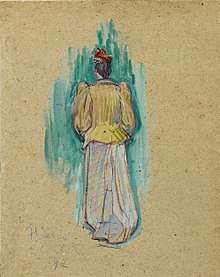
Toulouse-Lautrec was mocked for his short stature and physical appearance, which led him to abuse alcohol.[33]
He initially drank only beer and wine, but his tastes expanded into liquor, namely absinthe.[21] The Earthquake cocktail (Tremblement de Terre) is attributed to Toulouse-Lautrec: a potent mixture containing half absinthe and half cognac in a wine goblet.[34] Due to his underdeveloped legs, he walked with the aid of a cane, which he hollowed out and kept filled with liquor in order to ensure that he was never without alcohol.[26][35]
Cooking skills
A fine and hospitable cook, Toulouse-Lautrec built up a collection of favorite recipes – some original, some adapted – which were posthumously published by his friend and dealer Maurice Joyant as L'Art de la Cuisine.[36] The book was republished in English translation in 1966 as The Art of Cuisine[37] – a tribute to his inventive (and wide-ranging) cooking.
Death
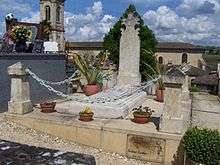
By February 1899, Toulouse-Lautrec's alcoholism began to take its toll and he collapsed from exhaustion and the effects of alcoholism. His family had him committed to Folie Saint-James, a sanatorium in Neuilly-sur-Seine for three months.[38] While he was committed, he drew 39 circus portraits. After his release, he returned to the Paris studio for a time and then traveled throughout France.[39] His physical and mental health began to decline rapidly owing to alcoholism and syphilis, which he reportedly contracted from Rosa La Rouge, a prostitute who was the subject of several of his paintings.[40]
On 9 September 1901, at the age of 36, he died from complications due to alcoholism and syphilis at his mother's estate, Château Malromé, in Saint-André-du-Bois. He is buried in Cimetière de Verdelais, Gironde, a few kilometers from the estate.[40][41] His last words reportedly were "Le vieux con!" ("the old fool"), his goodbye to his father,[26] though another version has been suggested, in which he used the word "hallali," a term used by huntsmen at the moment the hounds kill their prey: "Je savais, Papa, que vous ne manqueriez pas l'hallali" ("I knew, papa, that you wouldn't miss the death.").[42]
After Toulouse-Lautrec's death, his mother, Adèle Comtesse de Toulouse-Lautrec-Monfa, and his art dealer, Maurice Joyant, continued promoting his artwork. His mother contributed funds for a museum to be created in Albi, his birthplace, to show his works. This Musée Toulouse-Lautrec owns the most extensive of his works.
Art

_1891.jpg)
In his less-than-20-year career, Toulouse-Lautrec created:
- 737 canvased paintings
- 275 watercolors
- 363 prints and posters
- 5,084 drawings
- some ceramic and stained-glass work
- an unknown number of lost works[10]
His debt to the Impressionists, particularly the more figurative painters like Manet and Degas, is apparent, that within his works, one can draw parallels to the detached barmaid at A Bar at the Folies-Bergère by Manet and the behind-the-scenes ballet dancers of Degas. His style was also influenced by the classical Japanese woodprints, which became popular in art circles in Paris.[43]
He excelled at depicting people in their working environments, with the color and movement of the gaudy nightlife present but the glamour stripped away. He was a master at painting crowd scenes where each figure was highly individualized. At the time they were painted, the individual figures in his larger paintings could be identified by silhouette alone, and the names of many of these characters have been recorded. His treatment of his subject matter, whether as portraits, in scenes of Parisian nightlife, or as intimate studies, has been described as alternately "sympathetic" and "dispassionate".
Toulouse-Lautrec's skilled depiction of people relied on his painterly style, which is highly linear and emphasizes contour. He often applied paint in long, thin brushstrokes, which would leave much of the board underneath showing through the paint. Many of his works may be best described as "drawings in coloured paint."[44]
On 20 August 2018, Toulouse-Lautrec was the featured artist on the BBC television program Fake or Fortune?. Researchers attempted to discover whether he created two discovered sketchbooks.[45]
In popular culture
Films
- Moulin Rouge (1952), portrayed by José Ferrer
- Casino Royale (1967): Tremble dresses as Toulouse-Lautrec for Vesper
- The Aristocats (1970): As an animated painting kitten, voiced by Gary Dubin
- Revenge of the Pink Panther (1978), Clouseau, disguised as Toulouse-Lautrec, played by Peter Sellers
- Lautrec (1998), directed by Roger Planchon[46]
- Moulin Rouge! (2001), portrayed by John Leguizamo[47]
- Midnight in Paris (2011), portrayed by Vincent Menjou Cortes[48]
Television
- In SpongeBob SquarePants, in episode 11b of season 1. During a scene in which Patrick and SpongeBob are carrying Squidward around in servitude to him, with Squidward complaining it is "too hot" or "too wet," they stumble onto an aquatic version of the painting La Troupe de Mlle. Églantine. Squidward quips that it is "too loose, Lautrec."
- In Sesame Street, La Troupe de Mlle. Églantine was also used as an animation about the letter D for "dance".
Literature
- Sacré Bleu: A Comedy d'Art, by Christopher Moore, in which the bon vivant artist plays the role of co-detective with the fictional lead, Lucien Lessard, in trying to unravel the death of mutual friend Vincent van Gogh.
- Sayonara Sorcier, by Hozumi, a Japanese manga series where Toulouse-Lautrec appears as a main character aside Theodorus Van Gogh and Paul Gauguin.
- Lust for Life (1934), historical novel based on the life of Vincent van Gogh.
- Moulin Rouge (novel), by Pierre La Mure (1950), historical novel based on the life of Henri de Toulouse-Lautrec.
Selected works
- See also Category:Paintings by Henri de Toulouse-Lautrec.
Paintings
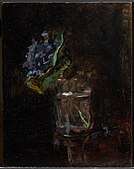 Bouquet of violets in a vase, 1882, oil on panel, Dallas Museum of Art
Bouquet of violets in a vase, 1882, oil on panel, Dallas Museum of Art_-_Henri_de_Toulouse-Lautrec.jpg) Portrait de Suzanne Valadon, 1885, oil on canvas, Museum, Buenos Aires
Portrait de Suzanne Valadon, 1885, oil on canvas, Museum, Buenos Aires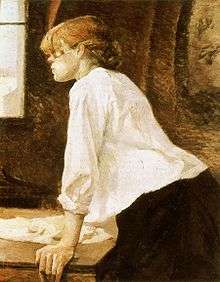 The Laundress, 1884–1888, oil on canvas, private collection
The Laundress, 1884–1888, oil on canvas, private collection Portrait of Vincent van Gogh, 1887, pastel on cardboard, Van Gogh Museum, Amsterdam
Portrait of Vincent van Gogh, 1887, pastel on cardboard, Van Gogh Museum, Amsterdam_1887-8.jpg) Equestrienne (At the Circus Fernando), 1888, oil on canvas, Art Institute of Chicago
Equestrienne (At the Circus Fernando), 1888, oil on canvas, Art Institute of Chicago At the Moulin Rouge 1890, oil on canvas, Philadelphia Museum of Art
At the Moulin Rouge 1890, oil on canvas, Philadelphia Museum of Art Portrait of Gabrielle, 1891, oil on cardboard, Museum Toulouse-Lautrec
Portrait of Gabrielle, 1891, oil on cardboard, Museum Toulouse-Lautrec
 At the Moulin Rouge (Two Women Waltzing), 1892, oil on cardboard, National Gallery in Prague
At the Moulin Rouge (Two Women Waltzing), 1892, oil on cardboard, National Gallery in Prague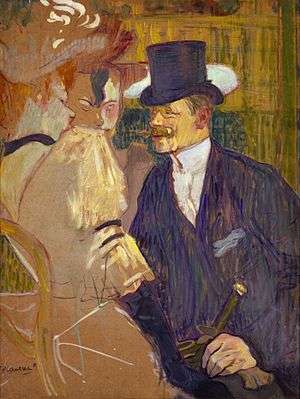 The Englishman at the Moulin Rouge, 1892, oil on cardboard, Metropolitan Museum of Art
The Englishman at the Moulin Rouge, 1892, oil on cardboard, Metropolitan Museum of Art Quadrille at the Moulin Rouge, 1892, oil and gouache on cardboard, National Gallery of Art
Quadrille at the Moulin Rouge, 1892, oil and gouache on cardboard, National Gallery of Art Jane Avril leaving the Moulin Rouge, c.1892, oil and gouache on cardboard, Wadsworth Atheneum Museum of Art
Jane Avril leaving the Moulin Rouge, c.1892, oil and gouache on cardboard, Wadsworth Atheneum Museum of Art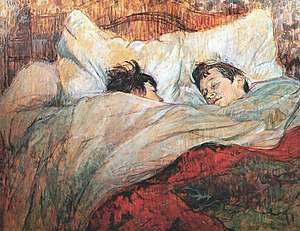 In Bed, 1893, oil on cardboard, Musée d'Orsay
In Bed, 1893, oil on cardboard, Musée d'Orsay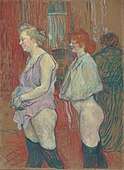 The Medical Inspection at the Rue des Moulins Brothel, 1894, oil on cardboard on wood, National Gallery of Art
The Medical Inspection at the Rue des Moulins Brothel, 1894, oil on cardboard on wood, National Gallery of Art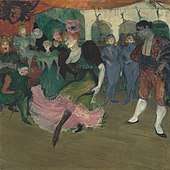 Marcelle Lender Dancing the Bolero in "Chilpéric", 1895–96, oil on canvas, National Gallery of Art
Marcelle Lender Dancing the Bolero in "Chilpéric", 1895–96, oil on canvas, National Gallery of Art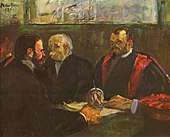 Examination at faculty of medicine, May–July 1901, oil on canvas – his last painting, Museum Toulouse-Lautrec
Examination at faculty of medicine, May–July 1901, oil on canvas – his last painting, Museum Toulouse-Lautrec
Posters
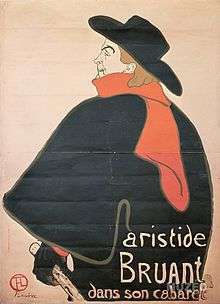 Aristide Bruant in his cabaret, 1892, lithography print
Aristide Bruant in his cabaret, 1892, lithography print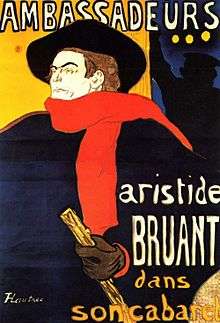 Ambassadeurs – Aristide Bruant, 1892, lithography print
Ambassadeurs – Aristide Bruant, 1892, lithography print_1892.jpg) Reine de Joie, 1892, chromolithography print
Reine de Joie, 1892, chromolithography print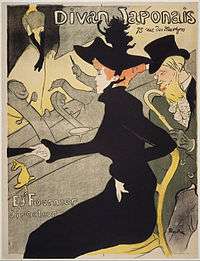 Divan Japonais, 1892–93, crayon, brush, spatter and transferred screen lithograph, printed in 4 color-layers
Divan Japonais, 1892–93, crayon, brush, spatter and transferred screen lithograph, printed in 4 color-layers Avril (Jane Avril), 1893, lithography printed in five colors
Avril (Jane Avril), 1893, lithography printed in five colors_1894.jpg) The German Babylon, 1894, lithography published by Victor Joze
The German Babylon, 1894, lithography published by Victor Joze
Photos
 Photo by Maurice Guibert c.1887
Photo by Maurice Guibert c.1887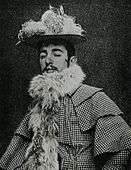 Photo by Maurice Guibert, 1892
Photo by Maurice Guibert, 1892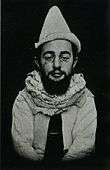 Photo by Maurice Guibert
Photo by Maurice Guibert.jpg) Lautrec with a nude model in his studio, by Maurice Guibert c. 1895
Lautrec with a nude model in his studio, by Maurice Guibert c. 1895
Other
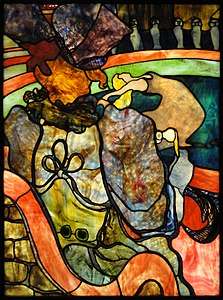 With Louis Comfort Tiffany, Au Nouveau Cirque, Papa Chrysanthème, c.1894, stained glass, 120 x 85 cm, Musée d'Orsay, Paris
With Louis Comfort Tiffany, Au Nouveau Cirque, Papa Chrysanthème, c.1894, stained glass, 120 x 85 cm, Musée d'Orsay, Paris- Miss Ida Heath, 1894, crayon and brush lithograph with scraper[49]
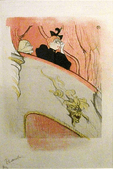 The Box with the Gilded Mask, 1894, color crayon, brush and spatter lithograph with scraper[50]
The Box with the Gilded Mask, 1894, color crayon, brush and spatter lithograph with scraper[50] The Jockey, 1899, mix of lithograph, oil and watercolor on paper, Brooklyn Museum
The Jockey, 1899, mix of lithograph, oil and watercolor on paper, Brooklyn Museum
See also
References
- Berwick, Carly (2 November 2005). "Toulouse-Lautrec Drives Big Night at Christie's". Nysun.com. Retrieved 12 August 2013.
- "Count Alphonse Charles de Toulouse Lautrec Monfa 1838–1913 Father of Henri de Toulouse Lautrec". gettyimages.co.uk.
- "Histoire et généalogie de la famille de Toulouse-Lautrec Montfa et de ses alliances". genealogie87.fr. Retrieved 17 February 2015.
- C., Ives. "Toulouse-Lautrec in the Metropolitan Museum of Art". Metropolitan Museum of Art, 1996. Retrieved 17 September 2019.
Comte Henri-Marie-Raymond de Toulouse-Lautrec 1864-1901
- Bellet, H. (24 April 2012). "Toulouse-Lautrec gallery at the Palais de Berbie - review". UK Guardian. Retrieved 17 September 2019.
From his father he would have inherited the title of Count of Toulouse-Lautrec.
- Author Unknown, "Toulouse-Lautrec" – published Grange Books. ISBN 1-84013-658-8 Bookfinder – Toulouse Lautrec
- ArT Blog : Toulouse-Lautrec at the Circus: The "Horse and Performer" Drawings Blogs.princeton.edu Archived 28 July 2009 at the Wayback Machine
- Toulouse-Lautrec, H., Natanson, T., & Frankfurter, A. M. (1950). Toulouse-Lautrec: the man. N.p. p. 120. OCLC 38609256
- "Why Lautrec was a giant". The Times. UK. 10 December 2006. Retrieved 8 December 2007.
- Angier, Natalie (6 June 1995). "What Ailed Toulouse-Lautrec? Scientists Zero in on a Key Gene". The New York Times. Retrieved 8 December 2007.
- "Noble figure". The Guardian. UK. 20 November 2004. Retrieved 8 December 2007.
- "The Shrinking of José Ferrer". Life. 33 (13): 51. 29 September 1952. ISSN 0024-3019.
- ""Henri de Toulouse-Lautrec". AMEA – World Museum of Erotic Art". Ameanet.org. 22 February 1999. Retrieved 12 August 2013.
- Ayto, John; Crofton, Ian (2006). Brewer's Dictionary of Modern Phrase & Fable. Weidenfeld & Nicolson. p. 747. ISBN 978-0-304-36809-9.
- "Le Rire".
- "The Marble Polisher (y1992-16)". Princeton University Art Museum. Princeton University.
- "Henri de Toulouse-Lautrec (1864–1901)". www.metmuseum.org. Retrieved 2 November 2019.
- "Paris Art Studies - Toulouse Lautrec Posters 1864–1901". www.parisartstudies.com. Retrieved 2 November 2019.
- Neret, Gilles (1999). Toulouse Lautrec. Taschen. p. 196.
- Gimferrer, Pere (1990). Toulouse Lautrec. Rizzoli. ISBN 0-8478-1276-6.
- Wittels, Betina; Hermesch, Robert (2008). Breaux, T. A. (ed.). Absinthe, Sip of Seduction: A Contemporary Guide. Fulcrum Publishing. p. 35. ISBN 978-1-933-10821-6.
- Powell, John; Blakeley, Derek W.; Powell, Tessa, eds. (2001). Biographical Dictionary of Literary Influences: The Nineteenth Century, 1800-1914. Greenwood Publishing Group. p. 417. ISBN 978-0-313-30422-4.
- (Toulouse-Lautrec, Donson 1982, p. XIV)
- Neret, Gilles (1999). Toulouse Lautrec. Germany: Taschen. pp. 134–135. ISBN 3-8228-6524-9.
- "Paris Art Studies - Toulouse Lautrec Posters 1864–1901". www.parisartstudies.com. Retrieved 2 November 2019.
- "Toulouse Lautrec: The Full Story". UK: Channel 4. Retrieved 1 October 2010.
- "Blake Linton Wilfong Hooker Heroes". Wondersmith.com. Retrieved 12 August 2013.
- Smith, Joan (10 July 1994). "Book Review/ Short and not sweet: Toulouse-Lautrec: A Life - Julia Frey: Weidenfeld, pounds 25". independent.co.uk. Retrieved 24 November 2014.
- Toulouse-Lautrec, Henri de; Donson, Theodore B. (1982). Great Lithographs by Toulouse-Lautrec. Griepp, Marvel M. Courier Corporation. p. XII. ISBN 978-0-486-24359-7.
- "Toulouse-Lautrec - TL. 14 - Confetti". www.yaneff.com. Retrieved 3 July 2019.
- Henri de Toulouse-Lautrec (1896). "La Chaîne Simpson". San Diego Museum of Art. Retrieved 28 March 2013.
- "'Oscar Wilde' 1895 by Toulouse-Lautrec". Mystudios.com. Retrieved 12 August 2013.
- "Henri de Toulouse-Lautrec Biography". lautrec.info. Archived from the original on 21 June 2010.
- "Absinthe Service and Historic Cocktails". AbsintheOnline.com. Archived from the original on 23 October 2007. Retrieved 8 December 2007.
- Gately, Iain (2008). Drink, A Cultural History of Alcohol. Gotham books. p. 338. ISBN 978-1-592-40303-5.
- Toulouse-Lautrec
- Grigson, J. Jane Grigson's Vegetable Book (1984), p. 422.
- Clair, Jean, ed. (2004). The Great Parade: Portrait of the Artist as Clown. Galeries nationales du Grand Palais (France), National Gallery of Canada. Yale University Press. p. 170. ISBN 978-0-300-10375-5.
- (Toulouse-Lautrec, Donson 1982, p. V)
- "Henri De Toulouse-Lautrec Biography". toulouse-lautrec-foundation.org. Retrieved 24 March 2015.
- Bennett, Lennie (16 November 2003). "More than art's poster boy". St. Petersburg, Florida: sptimes.com. Retrieved 24 March 2015.
- "citations.com". citations.com. Archived from the original on 29 November 2014. Retrieved 12 August 2013.
- Berger, Klaus. (1992) Japonisme in Western Painting from Whistler to Matisse. Translated by David Britt. Cambridge: Cambridge University Press, p. 199. ISBN 9780521373210.
- "Henri Toulouse-Lautrec". Lefevre Fine Art. Retrieved 10 May 2019.
- BBC - Fake or Fiction?
- Variety; Cowie, Peter (1999). Variety (ed.). The Variety Insider. Penguin Group USA. p. 173. ISBN 978-0-399-52524-7.
- "Moulin Rouge!" IMDb.
- "Midnight in Paris (2011) | Full Cast & Crew", IMDb.
- "Miss Ida Heath, danseuse anglaise".
- https://www.metmuseum.org/art/collection/search/334189
Further reading
- Toulouse-Lautrec, Henri de; Donson, Theodore B.; Griepp, Marvel M. (1982). Great Lithographs by Toulouse-Lautrec. Courier Corporation. ISBN 9780486243597.
- Ives, Colta (1996). Toulouse-Lautrec in the Metropolitan Museum of Art. New York: The Metropolitan Museum of Art. ISBN 9780870998041.
- Sawyer, Kenneth B. "Art Notes: Lautrec Works Shown at Gutman Memorial", The Sun, 15 April 1956, 100.
- "Rites for Nelson Gutman to be at 11 A.M. Tomorrow", The Sun, 17 August 1955, 13.
- Henry, Helen. "Juanita Greif Gutman Art Treasures: Works form the Collection She Left the Baltimore Museum of Art Go on Exhibit Next Sunday", The Sun, 16 February 1964, SM9.
- "Gutman Show-Savor it Slow", The Sun, 8 March 1964 D4.
- "Mrs. Gutman Funeral Set: Noted Collector of Art, Rare Books Traveled Widely", The Sun, 7 September 1963, 1.
External links
| Look up milieu in Wiktionary, the free dictionary. |
| Wikimedia Commons has media related to: |
| Wikiquote has quotations related to: Henri de Toulouse-Lautrec |
- Henri de Toulouse-Lautrec at the Museum of Modern Art
- Toulouse-Lautrec and Montmartre at the National Gallery of Art
- Toulouse-Lautrec and Paris exhibition at the Sterling and Francine Clark Art Institute
- Henri de Toulouse-Lautrec – Artcyclopedia
- Young woman at a table, 'Poudre de riz', 1887 Henri de Toulouse-Lautrec Collection Van Gogh Museum
- Toulouse Lautrec Museum
- Bibliothèque numérique de l'INHA - Estampes de Henri de Toulouse-Lautrec (French National Institute of Art – Prints of Henri de Toulouse-Lautrec) (in French)
- Toulouse-Lautrec and Jane Avril beyond the Moulin Rouge - Courtauld Gallery, London
- Henri de Toulouse-Lautrec page on Check123 - Video Encyclopedia